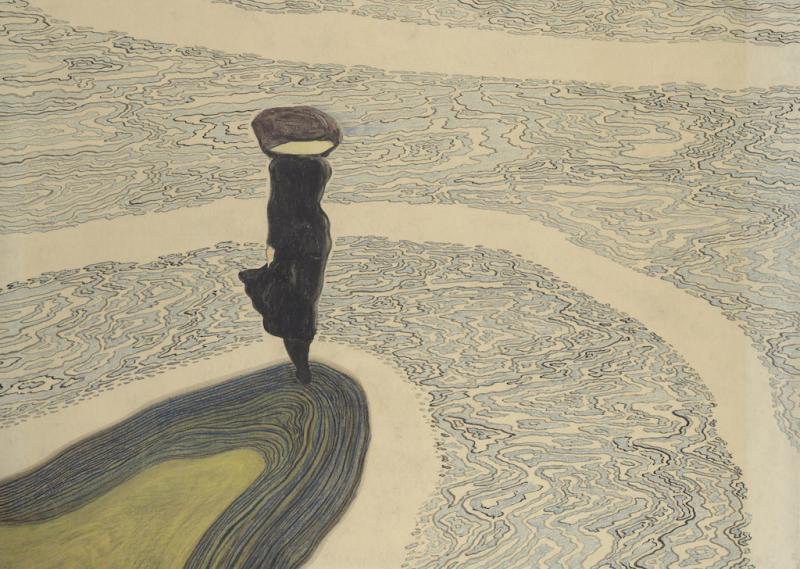Léon Spilliaert, Royal Academy review - a maudlin exploration of solitude | reviews, news & interviews
Léon Spilliaert, Royal Academy review - a maudlin exploration of solitude
Léon Spilliaert, Royal Academy review - a maudlin exploration of solitude
The world seen through the eyes of melancholy

What a spooky exhibition! Léon Spilliaert suffered from crippling insomnia and often spent the nocturnal hours in the conservatory of his parents’ house in Ostend drawing his haggard features (pictured below right: Self-portrait, 1907).
The artist also roamed the deserted streets and recorded them in sombre pictures whose unusual viewpoints and exaggerated perspectives create a filmic sense of dread. With towering walls reflected in wet tarmac, Hofstraat, Ostend from 1908 becomes a bleak canyon illuminated by a single, distant light. The same dramatic perspective channels one’s eye down Ostend’s empty pier towards the lighthouse at the end and the waves beyond. Spilliaert rented a studio overlooking the busy port, but instead of recording this hive of activity, he preferred to capture empty, windswept beaches and looming clouds.

Spilliaert married in 1917 and had a child, but only two drawings of his wife, Rachel, are on show. He was determined, it seems, to focus on the darker side of life. Misery, 1909 comprises a black garment hanging from a rope in a room empty save for a wooden trunk. Love, 1901 is an ink drawing of a scrawny little man clinging to a tall woman and gazing up at her with a mixture of devotion and despair. The couple are framed in a hoop of light that bleeds a sorrowful fringe of black ink from its lower edge.
Not surprisingly, Spilliaert was drawn to the dark fantasies of authors like Edgar Allan Poe and in 1902 he began illustrating the work of writers such as Maurice Maeterlinck and the Symbolist poet Emile Verhaeren, who shared his brooding intensity. All in all, this feels like a life lived in front of the mirror and the drawing board, rehearsing melancholy as well as experiencing its clutches.
rating
Explore topics
Share this article
Add comment
The future of Arts Journalism
You can stop theartsdesk.com closing!
We urgently need financing to survive. Our fundraising drive has thus far raised £49,000 but we need to reach £100,000 or we will be forced to close. Please contribute here: https://gofund.me/c3f6033d
And if you can forward this information to anyone who might assist, we’d be grateful.

Subscribe to theartsdesk.com
Thank you for continuing to read our work on theartsdesk.com. For unlimited access to every article in its entirety, including our archive of more than 15,000 pieces, we're asking for £5 per month or £40 per year. We feel it's a very good deal, and hope you do too.
To take a subscription now simply click here.
And if you're looking for that extra gift for a friend or family member, why not treat them to a theartsdesk.com gift subscription?
more Visual arts
 'We are bowled over!' Thank you for your messages of love and support
Much-appreciated words of commendation from readers and the cultural community
'We are bowled over!' Thank you for your messages of love and support
Much-appreciated words of commendation from readers and the cultural community
 Folkestone Triennial 2025 - landscape, seascape, art lovers' escape
Locally rooted festival brings home many but not all global concerns
Folkestone Triennial 2025 - landscape, seascape, art lovers' escape
Locally rooted festival brings home many but not all global concerns
 Sir Brian Clarke (1953-2025) - a personal tribute
Remembering an artist with a gift for the transcendent
Sir Brian Clarke (1953-2025) - a personal tribute
Remembering an artist with a gift for the transcendent
 Emily Kam Kngwarray, Tate Modern review - glimpses of another world
Pictures that are an affirmation of belonging
Emily Kam Kngwarray, Tate Modern review - glimpses of another world
Pictures that are an affirmation of belonging
 Kiefer / Van Gogh, Royal Academy review - a pairing of opposites
Small scale intensity meets large scale melodrama
Kiefer / Van Gogh, Royal Academy review - a pairing of opposites
Small scale intensity meets large scale melodrama
 Jenny Saville: The Anatomy of Painting, National Portrait Gallery review - a protégé losing her way
A brilliant painter in search of a worthwhile subject
Jenny Saville: The Anatomy of Painting, National Portrait Gallery review - a protégé losing her way
A brilliant painter in search of a worthwhile subject
 Abstract Erotic, Courtauld Gallery review - sculpture that is sensuous, funny and subversive
Testing the boundaries of good taste, and winning
Abstract Erotic, Courtauld Gallery review - sculpture that is sensuous, funny and subversive
Testing the boundaries of good taste, and winning
 Edward Burra, Tate Britain review - watercolour made mainstream
Social satire with a nasty bite
Edward Burra, Tate Britain review - watercolour made mainstream
Social satire with a nasty bite
 Ithell Colquhoun, Tate Britain review - revelations of a weird and wonderful world
Emanations from the unconscious
Ithell Colquhoun, Tate Britain review - revelations of a weird and wonderful world
Emanations from the unconscious
 Rachel Jones: Gated Canyons, Dulwich Picture Gallery review - teeth with a real bite
Mouths have never looked so good
Rachel Jones: Gated Canyons, Dulwich Picture Gallery review - teeth with a real bite
Mouths have never looked so good
 Yoshitomo Nara, Hayward Gallery review - sickeningly cute kids
How to make millions out of kitsch
Yoshitomo Nara, Hayward Gallery review - sickeningly cute kids
How to make millions out of kitsch
 Hamad Butt: Apprehensions, Whitechapel Gallery review - cool, calm and potentially lethal
The YBA who didn’t have time to become a household name
Hamad Butt: Apprehensions, Whitechapel Gallery review - cool, calm and potentially lethal
The YBA who didn’t have time to become a household name

Comments
It seems your beef is with